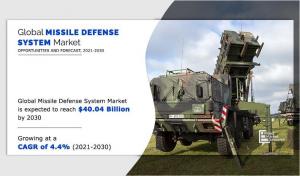Missile Defense Systems Market to Witness Remarkable Growth Set to Hits $40.04 Bn by 2030
The global missile defense systems market is driven by factors such as rise in number of conflicts and increase in spending for defense across the globe.
WILMINGTON, DE, UNITED STATES, June 25, 2025 /EINPresswire.com/ -- Missile defense systems market size garnered $26.16 billion in 2020, and is projected to generate $40.04 billion by 2030, with a noteworthy CAGR of 4.4% between the years 2021 to 2030.The global missile defense systems market is experiencing growth, primarily fueled by the rising number of geopolitical conflicts and increased defense spending worldwide. Nations are investing heavily in advanced defense technologies to enhance national security and deterrence capabilities. However, the high cost of missile defense systems remains a key challenge, potentially limiting adoption in some regions. Despite this, the market is poised for future expansion, driven by the growing integration of artificial intelligence in defense operations and accelerating efforts in the development and deployment of hypersonic missile technologies. These advancements are expected to open new avenues for innovation and growth in the missile defense sector over the coming years.
Download Sample Pages : https://www.alliedmarketresearch.com/request-sample/A11299
The increasing frequency of global conflicts, along with a surge in defense expenditures by nations worldwide, is expected to drive the growth of the missile defense systems market during the forecast period. Despite these drivers, the high costs associated with developing and deploying missile defense systems may act as a restraint on market expansion. Nevertheless, ongoing advancements in hypersonic missile deployment and the rising adoption of artificial intelligence in military operations are anticipated to create significant growth opportunities for the market in the coming years.
By region, the market across North America was largest in 2020, accounting for more than two-fifths of the global missile defense systems market revenue. The market is driven by high defense budget, surge in R&D activities, and technological advancements by top market players. However, the Asia-Pacific region is projected to experience a notable growth with 5.2% CAGR from 2021 to 2030, owing to high defense spending, rise in conflicts among developing countries, and surge in adoption of missile defense systems.
Buy This Research Report: https://www.alliedmarketresearch.com/missile-defense-systems-market/purchase-options
North America dominates the market, in terms of revenue, followed by Asia-Pacific, Europe, and LAMEA. The U.S. dominated the global missile defense systems Industry share in North America in 2020, owing to increase in R&D activities; technological developments by key players; rapid adoption of innovative technologies in making reliable, precise, and efficient missile defense systems. Asia-Pacific is expected to grow at a significant rate during the forecast period, owing to rise in adoption of missile defense systems along with its huge defense spending and the rise in conflicts across several Asian nations, for instance, China, India, Taiwan, Pakistan, and North Korea.
Leading market players:
The Boeing Company
Rheinmetall AG
Thales Group
Northrop Grumman Corporation
Raytheon Technologies Corporation
Lockheed Martin Corporation
MBDA
General Dynamics Corporation
Leonardo Spa
BAE Systems plc
For Purchase Enquiry: https://www.alliedmarketresearch.com/purchase-enquiry/A11299
Trending Reports:
Rocket and Missiles Market: https://www.alliedmarketresearch.com/rocket-and-missiles-market-A09635
Hypersonic Missiles Market: https://www.alliedmarketresearch.com/hypersonic-missile-market-A14493
Ballistic Missile Market: https://www.alliedmarketresearch.com/ballistic-missile-market-A10695
David Correa
Allied Market Research
+ 1800-792-5285
email us here
Visit us on social media:
LinkedIn
Facebook
YouTube
X
Legal Disclaimer:
EIN Presswire provides this news content "as is" without warranty of any kind. We do not accept any responsibility or liability for the accuracy, content, images, videos, licenses, completeness, legality, or reliability of the information contained in this article. If you have any complaints or copyright issues related to this article, kindly contact the author above.
Scale Selling Partners with Florists to Boost Online Visibility and Sales
Glossed Auto Detailing Announces Launch of Mobile Car Detailing Services in Fairfax, Virginia
Sogdiana Pain Management Center Offers Holistic Healing to Richmond Hill and the GTA
Więcej ważnych informacji
 Jedynka Newserii
Jedynka Newserii

 Jedynka Newserii
Jedynka Newserii

Polityka

D. Joński: Nie wiemy, co zrobi Rosja za dwa–trzy lata. Według duńskiego wywiadu może zaatakować kraje nadbałtyckie i musimy być na to gotowi
Zdecydowana większość krajów unijnych wskazuje na potrzebę wzmocnienia zdolności obronnych Europy w obliczu coraz bardziej złożonego geopolitycznego tła. Wywiady zachodnich państw wskazują, że Rosja może rozpocząć konfrontację z NATO jeszcze przed 2030 rokiem. Biała księga w sprawie obronności europejskiej „Gotowość 2030” zakłada m.in. ochronę granic lądowych, powietrznych i morskich UE, a sztandarowym projektem ma być Tarcza Wschód. – W budzeniu Europy duże zasługi ma polska prezydencja – ocenia europoseł Dariusz Joński.
Transport
Duże magazyny energii przyspieszą rozwój transportu niskoemisyjnego w Europie. Przyszłością może być wodór służący jako paliwo i nośnik energii

Zmiany w europejskim transporcie przyspieszają. Trendem jest elektromobilność, zwłaszcza w ramach logistyki „ostatniej mili”. Jednocześnie jednak udział samochodów w pełni elektrycznych w polskich firmach spadł z 18 do 12 proc., co wpisuje się w szerszy europejski trend spowolnienia elektromobilności. Główne bariery to ograniczona liczba publicznych stacji ładowania, wysoka cena pojazdów i brak dostępu do odpowiedniej infrastruktury. – Potrzebne są odpowiednio duże magazyny taniej energii. Przyszłością przede wszystkim jest wodór – ocenia Andrzej Gemra z Renault Group.
Infrastruktura
W Polsce w obiektach zabytkowych wciąż brakuje nowoczesnych rozwiązań przeciwpożarowych. Potrzebna jest większa elastyczność w stosowaniu przepisów

Pogodzenie interesów konserwatorów, projektantów, inwestorów, rzeczoznawców i służby ochrony pożarowej stanowi jedno z największych wyzwań w zakresie ochrony przeciwpożarowej obiektów konserwatorskich. Pożary zabytków takich jak m.in. katedra Notre-Dame w Paryżu przyczyniają się do wprowadzania nowatorskich rozwiązań technicznych w zakresie ochrony przeciwpożarowej. W Polsce obowiązuje już konieczność instalacji systemów detekcji. Inwestorzy często jednak rezygnują z realizacji projektów dotyczących obiektów zabytkowych z uwagi na zmieniające się i coraz bardziej restrykcyjne przepisy czy też względy ekonomiczne.
Partner serwisu
Szkolenia

Akademia Newserii
Akademia Newserii to projekt, w ramach którego najlepsi polscy dziennikarze biznesowi, giełdowi oraz lifestylowi, a także szkoleniowcy z wieloletnim doświadczeniem dzielą się swoją wiedzą nt. pracy z mediami.




![Nestlé w Polsce podsumowuje wpływ na krajową gospodarkę. Firma wygenerowała 0,6 proc. polskiego PKB [DEPESZA]](https://www.newseria.pl/files/1097841585/fabryka-nesquik_1,w_85,r_png,_small.png)




.gif)

 |
| |
| |
|